User:Johnpaulo5860/sandbox/nationalculturaltreasures
| This is not a Wikipedia article: It is an individual user's work-in-progress page, and may be incomplete and/or unreliable. For guidance on developing this draft, see Wikipedia:So you made a userspace draft. Find sources: Google (books · news · scholar · free images · WP refs) · FENS · JSTOR · TWL |
Natural National Cultural Treasures
[edit]| Official NCT Name | Current location | Period | Description | Legal Bases | Year declared |
|---|---|---|---|---|---|
Petroglyphs of Alab
|
Bontoc, Mountain Province | Bronze age
ca. 1500 BC[1] |
The Alab petroglyphs are ancient figures interpreted to as human genitalia carved on rock by the prehistoric people of Bontoc, Mountain Province. | PD 260, s. 1973[2] | 1973 |
 Mummy Caves of Kabayan, Benguet and of Sagada and Alab, Bontoc
|
|
14th-19th century[3] | 200 man-made burial caves, 15 of which contain preserved human mummies of the Ibaloi culture known as the Kabayan Mummies | PD 260, s. 1973[2] | 1973 |
| Burial caves | Bagulin, La union | More commonly known as the Kedlap Burial cave. Once a burial site containing wooden coffins of carabao zoomorphic designs | Proclamation no. 1683, s. 1977[4] | 1977 | |
Rizal Archaeological Reservation
|
Rizal, Kalinga | Neolithic to Protohistoric | Excavation site of prehistoric megafauna such as the rhinoceros and stegodon. [a] | 1977[b] [5] | |
 Tabon Caves Complex and all of Lipuun
|
Lipuun Point, Quezon, Palawan | ca. 9,000 BP[6] | The cave complex has an approximate area of 138 hectares, composed of 218 caves, 38 of which were used as habitation and burial sites in the past. Tabon Cave, one of the caves in the complex, yielded the earliest human remains found in the Philippines.[6] | NMP Declaration No. 1-2011[6] | 2011[6] |
| Dewil valley | Palawan | Neolithic to Protohistoric | Limestone Karst forest with evidences of Neolithic to Protohistoric human habitation such as shell middens and burial sites. | NMP Declaration No. 39-2020 | 2020[7] |
Tangible-movable National Cultural Treasures
[edit]| Official NCT Name | Current location | Period | Description | Legal Bases/ Official marker | Year declared |
|---|---|---|---|---|---|
 |
National Museum of Fine Arts, Ermita, Manila | 1884 | An oil-on-canvass painting depicting the assassination of Spanish governor-general Fernando Manuel de Bustillo Bustamante y Rueda in 1719. The painting won Hidalgo a silver medal in the 1884 Exposición Nacional de Bellas Artes in Madrid, Spain. |  |
1974[8] |
 |
National Museum- Butuan, Libertad, Butuan | 320 A.D. | Balangays are large plank boats that were used in the precolonial era. These ancient balangays were found in what used to be the Kingdom of Butuan. | Proclamation 86, s. 1987[9] | 1987 |
 History of Manila by Carlos V. Francisco
|
National Museum of Fine Arts, Ermita, Manila | 1968 | Also known as the Filipino struggles through history , this monumental painting depicting the History of Manila is painted by NA Carlos V. Francisco. |  |
1996[10] |
 |
National Museum- Vigan, Ilocos Sur | 1807 | The paintings depict the Basi Revolt, also known as the Ambaristo Revolt in 1807 which was held in opposition to taxes on liquor in the Ilocos against the Spanish. The series of 14 paintings by Esteban Pichay Villanueva currently hangs at the National Museum in Vigan. | 2009[11] | |
 |
National Library of the Philippines, Ermita, Manila | 18 million original pages of documentation from the Spanish colonial period dating as far as the 16th century [12] | [13][14] | ||
 |
National Museum of Fine Arts, Ermita, Manila | 1890 | An oil-on-canvass painting of master painter Simon Flores regarded as a transition from the miniaturist school of homegrown portraitists of the nineteenth century to the idyllic tableaux of the American period academic masters. | NMP Declaration No. 03-2008 | 2008[6] |
 Una Bulaqueña Painting by Juan Luna
|
National Museum of Fine Arts, Ermita, Manila | 1895 | Also known as La Bulaqueña, literally "the woman from Bulacan", the oil-on-canvass painting is portrait of a Emiliana Yriarte Trinidad, Filipino woman wearing a traditional Filipino dress. Painted by Juan Luna. |  |
2008[6] |
 Mother's Revenge
|
National Museum of Fine Arts, Ermita, Manila | 1894 | Made by revolutionary hero Jose Rizal during his exile in Dapitan. The terra cotta sculpture is an allegorical representation of the situation in the Philippines during the Spanish colonial period. | NMP Declaration No. 02-2008 | 2008[6] |
1 22 23 25 Artifacts and Ecofacts from Philippine Archaeological Sites |
National Museum of Anthropology, Ermita, Manila | Pleistocene (707,000 YA) – 15th century | National Cultural Treasures are as follows:
|
 25
NMP Declaration No. 3-2010[15] |
2010 |
 Spoliarium by: Juan Luna
|
National Museum of Fine Arts, Ermita, Manila | 1884 | An oil-on-canvass painting by Juan Luna considered by the Filipino art community as the most prized painting made by a Filipino master painter. |  |
2006[16] |
 |
National Museum of Fine Arts, Ermita, Manila | 18th century | A side altar from the St. Nicholas de Tolentine Parish in Dimiao, Bohol.[18] The retablo with traces of vibrant polychrome was made by an unknown master. | NMP Declaration No. 6-2011 | 2011 |
 |
National Museum of Fine Arts, Ermita, Manila | 1953 | The artwork comprise of four oil paintings on canvas created by NA Carlos V. Francisco in 1953 for the entrance of the Philippine General Hospital. This quadriptych depicts the history of medicine in the Philippines until the middle of the 20th century. | 2011[17] | |
 |
National Museum of Fine Arts, Ermita, Manila | Interior d'un Café (Parisian Life) by Juan Luna y Novicio (1857-1899) was exhibited in 1904 at the St Louis Exposition (World's Fair). | [6] | ||
 |
University of Santo Tomas, Sampaloc, Manila | 1613 | The UST Baybayin Documents are 17th century land deeds written in baybayin, an ancient Philippine syllabary or suyat. It is the first document to be declared a national cultural treasure. | 2014[19] | |
International Rice Research Institute by Vicente Manansala
|
National Museum of Fine Arts, Ermita, Manila | 1962 | Twin murals of NA Vicente Manansala portraying Filipino rural life. |  |
2015[20] |
 |
National Museum of Anthropology, Ermita, Manila | The oldest known Quran (Koran) in the Philippines. The Quran is believed to be one of the few copies translated into a non-Arabic language—that is, using a language in the Malay family and handwritten in Arabic calligraphy. | 2015[21] | ||
| Alcaiceria de San Fernando Marker of 1762 (from Binondo) | National Museum of Anthropology, Ermita, Manila | 1762 | A large stone tablet discovered at the Spanish colonial era site of the Alcaiceria de San Fernando- a customhouse and marketplace, an example of official regulations enacted by the Spanish colonial goverNMPent against the Chinese. | 2015[22] | |
1 2 3 4 Sacred Art of the Parish Church of Santiago Apostol (4 Paintings in Situ) |
Paete, Laguna | Four monumental paintings inside the St. James the Apostle Parish church in Paete, Laguna, which are:
|
Declaration No. 11-2015/13-2015[6] | 2015[21] | |
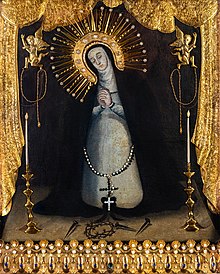 |
Diocesan Shrine of Our Lady of Solitude of Porta Vaga, Cavite City, Cavite | 1692 | A shrine containing a framed image of the Virgin that was found on the beach along Cañacao Bay by fishermen and local residents working at the Cavite Royal Arsenal | NMP declaration no. 2, s. 2017 [23] | 2017 |
 |
Vigan, Ilocos Sur | early 1990s | Archives of the Archdiocese of Nueva Segovia which contains documents as early as 1645. Notable documents are the death register of Gabriela Silang - a national hero of the Philippines and the baptismal records of Padre Jose Burgos- Filipino martyr | 2018[24] | |
Men at Work by Ang Kiukok
|
National Museum of Fine Arts, Ermita, Manila | 1979 | A semi-abstract triptych of men at work by NA Ang Kiukok commissioned for the National Manpower and Youth Commission which was displayed at the TESDA -NCR office. | 2021[25] | |
 |
Culion Island, Palawan | 2016 | Culion Museum and Archives (2016) of the Culion Leper colony, established in 1906 which once the largest leper colony in the world. [d] | 2024 [26][27] | |
 Noli Me Tangere
|
National Library of the Philippines, Ermita, Manila | Original manuscript of the first novel of Jose Rizal- Filipino polymath and Nationalist housed at the National Library of the Philippines | 2024 [28] | ||
 El Filibusterismo
|
National Library of the Philippines, Ermita, Manila | Original manuscript of the second novel of Jose Rizal- Filipino polymath and Nationalist housed at the National Library of the Philippines | 2024 [28] | ||
 Mi Ultimo Adios
|
National Library of the Philippines, Ermita, Manila | Original manuscript of the last poem of Jose Rizal- Filipino polymath and Nationalist housed at the National Library of the Philippines | 2024 [28] |
Tangible-immovable National Cultural Treasures
[edit]| Official NCT Name | Current location | Period | Description | Legal Bases | Year declared |
|---|---|---|---|---|---|
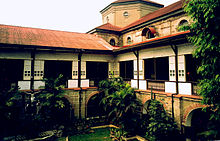 |
Santa Ana, Manila | 1725 | Contains artifacts collected from the archaeological excavations of the churchyard which was the 11th to 14th century AD settlement of the Kingdom of Namayan | PD 260, s. 1973[2] | 1973 |
 Paoay Church |
Paoay, Ilocos Norte | 1710 | The church, built by the Augustinians, is an outstanding example of Earthquake Baroque, with its large buttresses and superior craftsmanship. Part of 4 churches under the UNESCO world heritage site distinction under Baroque churches of the Philippines | PD 260, s. 1973[2] | 1973 |
 |
Bacarra, Ilocos Norte | 1782 | An Augustinian established Spanish colonial-era church built of brick and coral stone. The sites' main feature is the dome-less belfry. | PD 260, s. 1973[2] | 1973 |
 Church of San Agustin and Liturgical objects
|
Intramuros, Manila | 1607 | The oldest existing Roman Catholic church in the Philippines under the auspices of The Order of St. Augustine. Part of 4 churches under the UNESCO world heritage site distinction under Baroque churches of the Philippines | PD 260, s. 1973[2] | 1973 |
 |
Zamboanga City | 1635 | Formally known as Real Fuerza de Nuestra Señora del Pilar de Zaragoza, the 17th-century military defense fortress built by the Spanish colonial goverNMPent was used as the main line of defense in the Zamboanga region against Muslim pirates. It became Roman Catholic Marian shrine after apparitions were seen in 1734 and 1897 and also hosts the National Museum's Zamboanga branch. | PD 260, s. 1973[2] | 1973 |
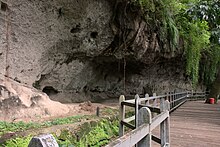 |
Binangonan, Rizal | 2000 BC | A series of 127 prehistoric figures carved on rock[29] | PD 260, s. 1973[2] | [e]1973[30] |
| Stone Agricultural Calendars of Dap-ay Guiday | Dap-ay, Guiday, Besao, Mountain Province | A stone calendar used by the Agawa people of Mountain Province. | PD 260, s. 1973[2] | 1973 | |
 |
Banaue, Ifugao | Series of rice terraces in the Cordillera highlands of the Philippines | PD 260, s. 1973[2] | 1973 | |
2 3 1 Mestizo Section, The Houses of Padre Jose Burgos and Leona Florentino in its Scope
|
Vigan, Ilocos Sur |
2. The Padre Jose Burgos house is the birthplace of Fr. Jose Burgos, one of the three Filipino martyrs known as Gomburza. 3. The Leona Florentino House is the expansive bahay na bato of Leona Florentino, Filipina poet and satirist in the Ilocano and Spanish Languages. |
PD 756, s. 1978 | 1978[31] | |
| Tau't Batu Petroglyphs | Quezon, Palawan | Anthropomorphic charcoal cave drawings in Ugpay cave | PD 1499, s. 1978 | 1978[32] | |
 |
Bacong, Negros Oriental | 1850 | Best preserved Spanish colonial-era church in Negros Oriental. |  |
2001[33] |
 |
Balayan, Batangas | 1795 | A well-preserved Spanish colonial-era church established by the Augustinian recollects. | NMP Declaration 2-2001 | 2001[33] |
 |
Betis, Guagua, Pampanga | 1770 | Famous for the moniker "Sistine chapel of the Philippines" for its intricate and well preserved ceiling paintings. |  |
2001[33] |
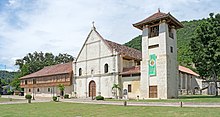 Church complex of Patrocinio de Maria – Boljoon Church Historical Landmark [k]
2 3 4 5 6 |
|
The (1) Patrocinio de Maria, more commonly known as Boljoon church is a church-convent complex built in the Spanish colonial era, known for its exquisite punch woodwork.
In 2018, as an expansion of the declaration of NCT, the following sites were included. 2. Sta. Catalina de Alejandria Church 6. La Inmaculada Concepcion |
(1)NMP Declaration 2-2001 | (1) 2001[33][34]
(2-6) 2018[35] | |
 |
Calasiao, Pangasinan | 1852 | A Spanish colonial-era church established by the Dominicans. Best-preserved church complex in Pangasinan. | NMP Declaration 2-2001 | 2001[33] |
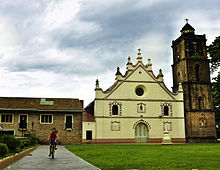 |
Dupax del Sur, Nueva Vizcaya | (1) 1776(2) 1818 | The (1)San Vicente Ferrer Church Complex is an 18th-century Baroque church known as the best preserved Spanish colonial-era church in the province of Nueva Vizcaya.
The (2) Dampol Bridge is a single-span brick and rock bridge built by the Isinai and other indigenous communities during the Spanish colonial era. The bridge having been integral to the San Vicente church complex has been added to its declaration in 2015 |
NMP Declaration 2-2001 | (1) 2001[33]
(2) 2015 [21] |
 |
Guiuan, Eastern Samar | 1844 | A Spanish colonial-era church established by the Jesuits and further ornamented by the Franciscans. Noted for its extensive shell ornamentation in its interiors.[36] | NMP Declaration 2-2001 | 2001[33] |
 |
Jasaan, Misamis Oriental | 19th century | A Spanish colonial-era church done in "barn-style" baroque noted for the facade's three stories of brick and wood. | NMP Declaration 2-2001 | 2001[33] |
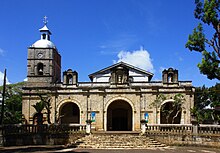 |
Jimenez, Misamis Occidental | 1880 | Also known as Jimenez Church, the structure is a late-19th century, Baroque church. | NMP Declaration 2-2001 | 2001[33] |
 Church complex of San Isidro Labrador [q]
|
Lazi, Siquijor | 1884 | A well preserved Spanish colonial-era church made of coral stone and wood. Noted for its intact and expansive convent | NMP Declaration 2-2001 | 2001[33] |
 |
Loboc, Bohol | 1734 | A Jesuit established Baroque church made of coral stone famed for its ceiling murals done by Canuto Avila and sons. | MD-2-2001 | 2001[33] |
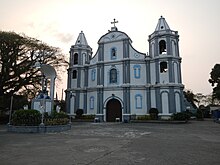 |
Luna, La Union | 1741 | More commonly known as the Namacpacan church, it is an example of a Spanish colonial-era earthquake baroque architecture. It is the home of the Our Lady of Namacpacan. | NMP Declaration 2-2001 | 2001[33] |
 |
Mahatao, Batanes | 1873 | Also known as Mahatao Church, the first church was constructed in 1787. By 1789, the wooden church was replaced by a stone church. When a typhoon hit the Batanes islands in 1872, the church was damaged and was replaced with a more sophisticated rock church in 1873, which continues to be the current church of Mahatao. | NMP Declaration 2-2001 | 2001[33] |
 |
Magsingal, Ilocos Sur | 1827 | A Spanish colonial era brick church noted for its unique and intricate retablo. | NMP Declaration 2-2001 | 2001[33] |
 |
Majayjay, Laguna | 1649 | A Spanish colonial-era Romanesque brick church[37]. Its convento is an early well-preserved example. | NMP Declaration 2-2001 | 2001[33] |
 |
Maragondon, Cavite | 1714 | A Spanish colonial-era church famed for its intricately carved woodwork and its polychromed retablos. | NMP Declaration 2-2001 | 2001[33] |
 |
Masinloc, Zambales | 18th Century | A 19th-century Baroque church built with coral stone instead of adobe stone. | NMP Declaration 2-2001 | 2001[33] |
 |
Panay, Capiz | 1884 | Commonly known as Panay Church, it was initially built in 1774, and was rebuilt in 1884 after the former structure was damaged by a typhoon. The church contains the largest bell in the country. | NMP Declaration 2-2001 | 2001[33] |
 |
Romblon, Romblon | 17th century | Spanish colonial era church known for its exquisite retablo. Seat of the Diocese of Romblon |  |
2001[33] |
 |
Rizal (Malaueg), Cagayan | 1617 | Spanish colonial era church established by the Dominicans. Noted for its compact architecture and extensive use of fired brick. | NMP Declaration 2-2001 | 2001[33] |
1 2 Church complex and Camposanto of San Joaquin[ab] |
San Joaquin, Iloilo | (1) 1869(2) 1892 | The (1) San Joaquin Parish church is a Spanish colonial era baroque church hewn from coral stone. Famous for the relief of the Rendicion de Tetuan on its facade.
The (2) Camposanto de San Joaquin is a catholic cemetery built in the Spanish colonial era famous for its impressive mortuary chapel. Added to the NCT declaration of the Church of San Joaquin in 2015. |
 |
(1) 2001[21]
(2) 2015 |
 |
Tabaco, Albay | 1879 | Founded in 1664, the present church was built by the seculars in 1864 and completed in 1879. | Museum Declaration 2-2001[6] | 2001[33] |
 |
Tanay, Rizal | 1783 | This Spanish colonial-era church is famed for the native inspired depiction of the Stations of the cross. | NMP Declaration 2-2001 | 2001[33] |
 1 3 6 Spanish Colonial-Era Church Complexes[af] |
Tayabas, Quezon | 1894 | Also known as the Basilica Minore de San Miguel Arkangel, this Spanish colonial era church is famous for its key-shaped layout and its long nave
In 2018, the site was expanded to include
|
NMP Declaration 2-2001
Expansion: MD-NO.1-2018 |
2001[33] |
 |
Tayum, Abra | 1803 | 19th-century Spanish colonial-era Baroque church | NMP Declaration 2-2001 | 2001[33] |
 Church of San Mattias, Tumauini [ah]
|
Tumauini, Isabela | 1783 | An Ultrabaroque style brick church. Its belfry is the only known Spanish colonial-era cylindrical tower in the country. | NMP Declaration 2-2001 | 2001[33] |
 |
Las Piñas, Metro Manila | 1824 | The Bamboo Organ is the only known oldest and largest bamboo organ existing in the world today with a unique and distinct sound as compared to other pipe organs, built by Fr. Diego Cera |  |
2003[6] |
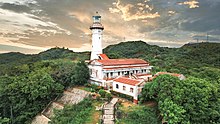 |
Burgos, Ilocos Norte | 1892 | Spanish colonial-era Lighthouse made of brick and wood. Still in use, the site is managed by the Philippine coast guard | 2005[38] | |
 |
Dapitan, Zamboanga del Norte | 1892 | Jose Rizal made this map from August to September 1892 assisted by Francisco Paula de Sanchez, his favorite teacher in Ateneo de Manila. It was intended as a way for teaching geography and history to Rizal's pupils in Dapitan and part of Rizal's beautification project to the town plaza. | 2005[6] | |
 |
Daraga, Albay | 1773 | The church is known for its Churrigueresque architectural style in its façade, a fine example of Baroque architecture, and made out of volcanic rocks, which are rich in the area.[39][40] | 2007[41] | |
 |
Santa Ana, Manila | c. 1720–1725 | Chapel room inside the Santa Ana church which functions as the dressing room of the Nuestra Señora delos Desamparados | 2008[42] | |
| Maranao Torogon | Pompongan-a-marantao, Marawi, Lanao del Sur | 1900 | Commonly known as Kawayan Torogan, the specific structure is a traditional Maranao torogan (house) built by Sultan sa Kawayan Makaantal. It is the last standing example of the house of the elite members of the Maranaos, and the only remaining habitable torogan. | NMP Declaration No. 4-2008 | 2008[43] |
 Bonifacio National Monument
|
Caloocan, Metro Manila | 1933 | Known commonly as Monumento, it is a monument designed by the NA Guillermo Tolentino to commemorate Philippine revolutionary Andrés Bonifacio, the founder and Supremo of the Katipunan. | 2009 | |
1 2 University of Santo Tomas Main Building, Central Seminary, Arch of the Centuries and Open Spaces |
Sampaloc, Manila | 1611 | The University of Santo Tomas itself was established in 1611, possessing the oldest extant university charter in Asia. In 1927, the (1) UST Main Building was re-established in its current location. The (2) Arch of the Centuries, first constructed in 1680, was transferred in the new campus in 1954 from the original site of UST in Intramuros which was destroyed during World War 2. | NMP Declaration no. 1-2010 | 2010[6] |
 |
Maribojoc, Bohol | 1852 to 1872 | Spanish colonial era Baroque church built by order made of coral stone and rock. | NMP Declaration No. 2-2010 | 2010[6] |
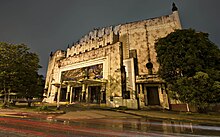 |
Ermita, Manila | 1931 | Also known as Manila Metropolitan theater, the Art Deco building designed by architect and NA Juan M. Arellano. |  |
2010[44] |
 Baclayon Church Historical Landmark
|
Baclayon, Bohol | 1727 | Best-preserved Spanish colonial-era Jesuit stone church in the Philippines | 2010[45] | |
 |
Loon, Bohol | 1864 | An expansive and grand example of Recollect Baroque Architecture in the Philippines.
Includes the Inang-angan coralstone stairway |
2010[45] | |
1 2 3 6 Bohol Watchtowers (6) |
17th century – 18th century | A series of six watchtowers in Bohol. They include the
|
Declaration No. 11-2011 | 2011[6] | |
1 2 5 9 |
Tayabas, Quezon | 1793-1854 | A series Spanish colonial era of bridges which include, but are not limited to:
|
2011 | |
 |
Dimiao, Bohol | 19th century | Baroque church surrounded by ruins of the ermita, an walled cemetery containing humans skulls exhibiting tooth-filing | 2011[6] | |
 |
Dauis, Bohol | 1697 | Spanish colonial era Gothic church built by order made of coral stone and rock. | NMP Declaration No. 12-2011 | 2011[6] |
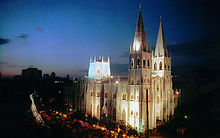 |
Quiapo, Manila | 1891 | A Neogothic basilica famed as being the only all-steel church in the country. |  |
2011[6] |
 |
Minalin, Pampanga | 1834 | Spanish colonial-era church made of brick and mortar. Notable for its retablo-like facade. |  |
2011[46] |
 Sto Domingo church complex and its ecclesiastical objects
|
Quezon City, Metro Manila | 1954 | Also known as the National Shrine of Our Lady of the Holy Rosary of La Naval de Manila, it is the largest church in Metro Manila and one of the biggest churches in Asia and serves as the base of the Dominicans in the Philippines. The church contains works murals painted by NA Carlos “Botong” Francisco, which shows the life of St. Dominic de Guzman |  |
2012 [47] |
 Twin Forts of Romblon ( Fuerza de San Antonio and Fuerza de Santiago) |
Romblon, Romblon | 1573 and 1760 respectively | Spanish colonial era fortresses above (1)San Andres (San Antonio) and (2)Calvary Hills (Santiago) |  |
2013[6] |
 |
Loay, Bohol | 1822 | Baroque-Renaissance Spanish Colonial era church made from cut coral stone. | MD-7-2013; October 22, 2013 | 2013[48] |
 |
Cortes, Bohol | 19th century | Baroque-Renaissance Spanish Colonial era church made from cut coral stone. | MD- 8-2013; October 22, 2013 | 2013[48] |
 |
Ermita, Manila | 1913 | Entitled Motto Stella (guiding star), the monument is a memorial in Rizal Park made by Richard Kissling built to commemorate the executed Filipino nationalist, José Rizal. The monument contains his bones which were re-interred in 1912[49]. |  |
2013[50] [48] |
 |
Santa Barbara, Iloilo | 1845 | Baroque-Renaissance, Spanish colonial era Augustinian church. Headquarters of Martin Delgado- General of the Phillippine Revolution |  |
2013[6] |
1 2 The Fortifications of Manila : Intramuros and Fort San Antonio Abad
|
(1) Intramuros, Manila(2) Malate, Manila | (1) 1571- 1862(2) 1584 | (1) Intramuros is a walled city, built during the of the Spanish Colonial Period was synonymous to the City of Manila, having been the center of administrative and religious power in the region.[ai]
(2)Spanish colonial era fort famously captured by the British n 1762. |
NMP Declaration No. 10-2014 | 2014[6] |
 Parish Church of the Santo Tomas de Villanueva of Miagao
|
Miagao, Iloilo | 1797 | Late 18th century Spanish colonial church dedicated to St Thomas de Villanueva. Excellent example of Earthquake baroque. Part of 4 churches under the UNESCO world heritage site distinction under Baroque churches of the Philippines | 2014[51] | |
 |
Capul, Northern Samar | 1781 | A Spanish-era fortress church.[52][53] | 2014[6] | |
 |
Manaoag, Pangasinan | 1701 | Includes the image of the Blessed Virgin Mary and movable and intangible properties intrinsic to the cultural significance of the property | 2015[21] | |
 |
Paco, Manila | 1822 | The cemetery-park is a recreational garden and was once Manila's municipal cemetery built by the Dominicans during the Spanish colonial period. The cemetery was initially built due to a cholera epidemic in the early 19th century. Nationalist Jose Rizal and Priests Gomburza are notable burials. | 2015[21] | |
3 4 5 Watchtowers of Ilocos Norte (6) |
Ilocos Norte | Spanish colonial era watchtowers which includes : | 2015[21] | ||
2 4 Watchtowers of Ilocos Sur (4) |
Ilocos Sur | Spanish colonial era watchtowers which includes :
|
2015[21] | ||

1 La Union Watchtowers |
Spanish colonial era | Spanish colonial era watchtowers of the province of La union which include the
|
2015[54] | ||
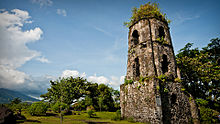 |
Daraga, Albay | 1724 | The present ruins are from the 1724 structure of the church, which was engulfed by a volcanic eruption in 1814. The original structure was built in 1587. | 2015[21] | |
 Santa Maria Church Complex and Cemetery
|
Santa Maria, Ilocos Sur | 1765 | Spanish colonial-era Baroque brick structure unique in its function as both church and citadel. [aj] | 2015 | |
 |
Silang, Cavite | 1595 | Spanish colonial era church in the baroque style with outstanding and culturally significant rococo altar pieces | 2016 [55] | |
 |
Ermita, Manila | 1918 | Designed Arc. Ralph Harrington Doane and Antonio Toledo. Home of the Philippine Legislature, National Assembly of the Philippines, Commonwealth Congress and the Philippine Congress. Now houses the National Museum of Fine Arts | NMP Declaration No. 07-2016 | 2016 |
 |
Manila | 1930s | A neoclassic building designed by architect Antonio Toledo during the Philippine Commonwealth era. Now houses the National Museum of Natural History | NMP Declaration No. 05-2016 | 2016 [6] |
1 2 Camiguin Archaeological Sites Sunken Cemetery (and) Old Bonbon Church Ruins |
Catarman, Camiguin |
|
The sunken cemetery (1) and the church of Bonbon (2) Ruins are spanish colonial era sites in Catarman destroyed during the eruption of Mt. Hibok-Hibok | NMP Declaration No. 1-2017[6] | 2016[48] |
| Guinsiliban Moro Watchtower | Guinsiliban, Camiguin | Spanish colonial era brick watchtower believed to be part of a larger structure used to guard the location from pirate attacks | NMP Declaration No. 1-2017[6] | 2016[48] | |
| Pila Archeaological Site | Pila, Laguna | 12th century | Also known as the Locsin Archaeological site, contains Iron age artifacts from the precolonial settlement of Pinagbayanan | 2016[48] | |
 |
Caloocan city | 1884 | Mortuary Chapel of the La Loma Cemetery. Oldest extant funerary chapel and cemetery grounds in Manila [56] | 2016[48] | |
 |
Manila | 1939 | Art deco steel bridge designed by NA Juan Arellano built during the Philippine Commonwealth era. Restored after being badly damaged during the Liberation of Manila. | NMP Declaration No. 02-2016 | 2016 [6] |
1 2 3 4 Colonial Monuments of Manila |
Intramuros, Manila | 19th Century | Monuments of monarchs and leaders during near the end of the Spanish colonial era. | NMP Declaration No. 09-2016 | 2016 [6] |
| Ayusan-Paoa Bridge (Puente de Paoa) | Vigan, Ilocos Sur | 1852 | Spanish colonial era brick arch bridge | 2016[57] | |
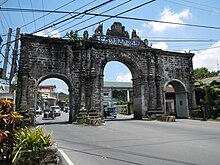 |
Pagsanjan, Laguna | 1878 | Arch was built by the locals to express gratitude to the Our Lady of Guadalupe, from protecting the town from bandits | 2016[58] | |
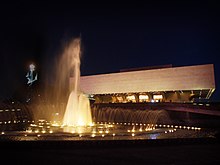 Tanghalang Pambansa of the Cultural Center of the Philippines by NA Arch. Leandro Locsin
|
Pasay city | 1969 | Designed by NA Leandro Locsin, this brutalist structure contains theatres and exhibition halls.
The declaration also includes the following works
|
2018[35] | |
 |
San Miguel, Manila | 1925 | Neo-gothic church of the San Beda college managed by the Benedictines | 2017[59] | |
 |
Pasig city | 1846 | Spanish colonial era Bahay na Bato | 2017[59] | |
 |
Baclaran, Paranaque | 1958 | Colloquially known as Baclaran church, this Romanesque revival church is the headquarters of the Manila Vice Province of the Redemptorists. | 2017[59] | |
Main Building & Complex of Quezon Institute by NA Juan Nakpil
|
Quezon city | 1938 | An art deco hospital designed by NA Juan Nakpil focused on the treatment of tuberculosis | 2018[35] | |
 Casa Real Ruins |
San Pablo, Isabela | 1624 | Ruins of a Spanish colonial-era baroque church and casa real | 2018[35] | |
1 2 3 Buildings of the Philippine Normal University |
Taft Avenue, Ermita, Manila | Early 1920s | The National Center for teacher education, established during the American occupation in 1901.
Includes:
|
 |
2018[6] |
 Original Sculpture in concrete and cast in bronze of "Oblation" by NA Guillermo Tolentino
|
Diliman, Quezon City | 1939 | Depicts a man facing upward with arms outstretched which became a symbol of the University of the Philippines. Sculpted by NA Guillermo Tolentino | 2018[35] | |
 Cavite puerto |
Cavite city | Spanish colonial era | Seaport area established during the Spanish colonial period.
Includes
|
2018[35] | |
1 2 3 Buildings of the Far Eastern University |
Sampaloc, Manila | 1938-1950 | The six buildings of the university is recognized for its well-preserved Art Deco and International style buildings designed by National Artist Pablo Antonio and his son Pablo Jr.
Includes:
|
 |
2018[6] |
| Fort Nuestra Señora de Guadalupe, and its Intrinsic Natural Setting at Tubigan Point | San Jose de Buenavista, Antique | 16th century | Spanish colonial-era fort | MD No. 13-2020 | 2019 [6] |
1 6 7 Spanish Colonial Era Fortifications of Palawan and its intrinsic natural setting |
|
Series of Spanish colonial era forts in the Province of Palawan.
Includes:
|
MD No. 14-2020 (June 27, 2019) | 2019[6] | |
 Sandugo
|
Tagbilaran, Bohol | Monument commemorating the Blood compact of Spanish explorer Miguel López de Legazpi and Datu Sikatuna, the chieftain of Bohol. Work by NA Napoleon V. Abueva | MD-9-2020 | 2019[6] | |
| Old Bridge of Paoay | Paoay, Ilocos Norte | 19th century | A single-arch brick baroque bridge near the Paoay church | NMP declaration no. 34-2020[62] | 2020 |
 |
Quezon City, Metro Manila | 1978 | Memorial and Final Resting Place of Manuel L. Quezon- First President of the Philippine Commonwealth, and Aurora A. Quezon, First Lady | NMP Declaration No. 29-2020 | 2020 |
2 3 1 |
Taal, Batangas | Spanish colonial-era church complex brought about by the devotion of the people to the Our Lady of Caysasay.
Includes the
|
NMP Declaration No. 32-2020[35] | 2020 | |
 |
Tagbilaran, Bohol | 1831 | Oldest Bahay na Bato in the province of Bohol. Acquired by the National Museum in 2020. [63] | NMP Panel of Experts Resolution No. 2-2020[64] | 2020 |
 |
Binondo, Manila | 1880s | Panciteria Macanista de Buen Gusto mentioned in El Filibusterismo | 2020[65] | |
 |
Cebu City | 1738 | Oldest triangular bastion Spanish colonial era fort in the country | NMP Declaration No. 12-2020 | 2020[6] |
 |
Cebu City | 1910 | Formerly a customs building and the official residence of the President of the Philippines in Cebu. Now the National Museum of the Philippines – Cebu | NMP Declaration No. 12-2020 | 2020[6] |
 |
Cebu City | NMP Declaration No. 12-2020 | 2020[6] | ||
 |
Cebu City | Monument to conquistador Miguel Lopez de Legaspi | NMP Declaration No. 12-2020 | 2020[6] | |
1 3 Watchtowers of Quezon |
(2) 1766
(3) 1752 (5)1855 |
Spanish colonial-era watchtowers used by the locals to guard their territories against Moro and pirate raids.
Includes
|
Museum Declaration no. 54-2020 | 2020[66] | |
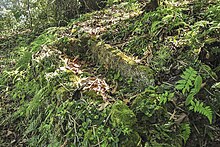 |
Mulanay, Quezon | c. 9th century | Site of a 9th century burial site which features limestone coffins. | 2020[67] | |
 |
San Vicente, Ilocos Sur | 1795 | The complex is an excellent example of Spanish colonial landscape planning. | 2020[68] | |
 |
Calape, Bohol | 1802 | Neo-gothic church established by the Augustinian recollects. | NMP Declaration No. 59-2020 | 2020[69] |
| Budiao church ruins | Daraga, Albay | 1798 | Ruins of a Spanish colonial-era baroque church destroyed durin the eruption of Mt. Mayon | NMP Declaration No. 40-2020 | 2020 [67] |
| Taytay-Boni Bridge | Miag-ao, Iloilo | 1854 | Spanish colonial -era coral stone bridge | NMP Declaration No. 36-2000[70] | 2020[71] |
1 2 Basilica del Santo Niño and Convent Pavilion of Magellan’s Cross |
Cebu City | 18th century |
|
 |
2021[35] |
 |
Pasay, Metro Manila | 1976 | Asia's first convention center designed by National Artist Leandro Locsin. The declaration includes the following as NCT
|
2022 | |
 |
Simunul, Tawi-Tawi | 1380 | Known as the birthplace of Islam in the Philippines built by Arab trader and missionary Makhdum Karim in 1380 | [73] | |
| Shell Midden sites |
Cagayan |
Neolithic era | A prehistoric dumpsite of mostly mollusk shells revealing information about eating habits and diets of ancient ancestors[ak] | [74] |
Intangible National Cultural Treasures
[edit]| Official NCT Name | Current location | Period | Description | Legal Bases | Year declared |
|---|---|---|---|---|---|
 1
Philippine Paleographs (Hanunoo, Build, Tagbanua and Pala'wan) |
Mindoro and Palawan |
|
NMP Declaration No. 001-97[6] | (as a whole) 1997
4. 1974[75] | |
 |
Ifugao province | unknown | The Hudhud consists of 200 narrative chants traditionally performed by the Ifugao community, most especially in the process of the rice harvest [76] | NMP Declaration No. 002-01[6] | 2001[77] |
 |
Lake Lanao, Lanao del Sur | AD 100 | An ancient pre-Islamic epic song that encompasses a wealth of knowledge of the Maranao people who live in the Lake Lanao region of Mindanao.[am] | Declaration No. 01-2002 | 2002[6] |
- ^ "Alab Petroglyphs". Atlas Obscura. Retrieved 2024-10-25.
- ^ a b c d e f g h i j "PRESIDENTIAL DECREE NO. 260, August 01, 1973 DECLARING THE STA. ANA SITE MUSEUM IN MANILA, THE ROMAN CATHOLIC CHURCHES OF PAOAY AND BACARRA IN ILOCOS NORTE, THE SAN AGUSTIN CHURCH AND LITURGICAL OBJECTS THEREIN IN INTRAMUROS, MANILA, FORT PILAR IN ZAMBOANGA CITY, THE PETROGLYPHS OF THE ROCK-SHELTER IN ANGONO, RIZAL, THE PETROGLYPHS OF ALAB, BONTOC, THE STONE AGRICULTURAL CALENDARS OF DAP-AY GUIDAY IN BESAO, BONTOC, THE MUMMY CAVES OF KABAYAN, BENGUET AND OF SAGADA AND ALAB, BONTOC, THE IFUGAO RICE TERRACES OF BANAUE AS NATIONAL CULTURAL TREASURES; AND THE BARASOAIN CHURCH IN MALOLOS, BULACAN, TIRAD PASS IN CERVANTES, ILOCOS SUR, THE MIAGAO CHURCH IN MIAGAO, ILOILO, THE SITE OF THE BATTLE OF MACTAN ON MACTAN ISLAND, CEBU, THE SAN SEBASTIAN CHURCH IN QUIAPO, MANILA, AND THE CHURCH AND CONVENT OF SANTO NINO IN CEBU CITY AS NATIONAL SHRINES, MONUMENTS, AND/OR LANDMARKS, DEFINING THE IMPLEMENTING AGENCIES AND PROVIDING FUNDS THEREFOR".
- ^ Balangcod, Teodora. "https://nopr.niscpr.res.in/bitstream/123456789/43647/1/IJTK%2017(2)%20307-313.pdf" (PDF).
{{cite web}}: External link in|title= - ^ "DECLARING THE BURIAL CAVES AT SITIO ALABOK, BARANGAY CAMBALI, BAGULIN, LA UNION, AS A NATIONAL CULTURAL TREASURE".
- ^ https://mirror.pia.gov.ph/news/2023/05/17/rizal-archaeological-site-declared-as-national-cultural-treasure.
{{cite web}}: Missing or empty|title=(help) - ^ a b c d e f g h i j k l m n o p q r s t u v w x y z aa ab ac ad ae af ag ah ai aj ak al am "TALAPAMANA".
- ^ Guiroy, Patricia Laririt and Jeshyl (2022-02-06). "National Museum declares Dewil Valley in El Nido a 'national cultural treasure'". PALAWAN NEWS. Retrieved 2024-10-26.
- ^ "Treasures of Philippine art El Asasenato del Gobernador Bustamante" (PDF).
- ^ "DECLARING THE BALANGAYS IN THE VICINITIES OF BUTUAN CITY, NATIONAL CULTURAL TREASURES; AND THE SITES WHERE THESE BALANGAYS ARE FOUND, ARCHAEOLOGICAL SITES, IN ACCORDANCE WITH SECTIONS 3 (c) AND 3 (j), RESPECTIVELY, OF REPUBLIC ACT NO. 4846, AS AMENDED, OTHERWISE KNOWN AS THE "CULTURAL PROPERTIES PRESERVATION AND PROTECTION ACT"".
- ^ "One of Botong Francisco's Most Famous Murals is Now on Display at the National Museum".
- ^ "The Basi Revolt – National Museum". Retrieved 2024-10-26.
- ^ "PressReader.com - Digital Newspaper & Magazine Subscriptions". www.pressreader.com. Retrieved 2024-10-27.
- ^ "PressReader.com - Digital Newspaper & Magazine Subscriptions". www.pressreader.com. Retrieved 2024-10-27.
- ^ https://nationalarchives.gov.ph/spanish-document-section-and-reading-room-closure/.
{{cite web}}: Missing or empty|title=(help) - ^ Baretto-Tesoro, Grace. "Ceramics make strange bedfellows: The contributions of the Oriental Ceramics Society of the Philippines to Philippine archaeology".
- ^ Nueva, Julan Shirwod (2019-05-24), English: Marker of Spoliarium by Juan Luna, retrieved 2024-10-31
- ^ a b "2014 National Museum Annual Report" (PDF).
- ^ "Tempest in the pulpit (B)". Manila Bulletin. Retrieved 2024-10-25.
- ^ "UST documents in ancient 'baybayin' script declared a National Cultural Treasure". Lifestyle.INQ. 2014-08-24. Retrieved 2024-10-26.
- ^ "Manansala murals of Irri declared National Cultural Treasures". Lifestyle.INQ. 2015-07-05. Retrieved 2024-10-26.
- ^ a b c d e f g h i News, G. M. A. (2015-12-24). "New National Cultural Treasures, Important Cultural Properties revealed by National Museum". GMA News Online. Retrieved 2024-10-26.
{{cite web}}:|last=has generic name (help) - ^ "Why San Nicolas is Manila's heritage district". Lifestyle.INQ. 2020-11-02. Retrieved 2024-10-26.
- ^ carballo, Percy s a (2019-03-31), English: REPUBLIC OF THE PHILIPPINES, retrieved 2024-10-26
- ^ "Nueva Segovia archives declared 'national treasure'". CBCPNews. 2018-12-07. Retrieved 2024-10-27.
- ^ Philippines, National Museum of the (2022-05-01). ""Men at Work" by National Artist Ang Kiukok – National Museum". Retrieved 2024-10-26.
- ^ Formoso, Celeste Anna (2024-09-09). "Culion Museum declared national treasure". Daily Tribune. Retrieved 2024-10-27.
- ^ Formoso, Celeste Anna (2024-09-08). "Leprosy patients' lives immortalized in Culion Museum and Archives". PALAWAN NEWS. Retrieved 2024-10-27.
- ^ a b c "#𝗡𝗮𝘁𝗶𝗼𝗻𝗮𝗹𝗟𝗶𝗯𝗿𝗮𝗿𝘆𝗣𝗛 𝗗𝗲𝗰𝗹𝗮𝗿𝗲𝘀 𝗥𝗶𝘇𝗮𝗹 𝗠𝗮𝗻𝘂𝘀𝗰𝗿𝗶𝗽𝘁𝘀 𝗮𝘀 𝗡𝗮𝘁𝗶𝗼𝗻𝗮𝗹 𝗖𝘂𝗹𝘁𝘂𝗿𝗮𝗹 𝗧𝗿𝗲𝗮𝘀𝘂𝗿𝗲𝘀 – National Library of the Philippines". Retrieved 2024-10-26.
- ^ "The Angono-Binangonan Petroglyphs". Artes de las Islas Filipinas. Retrieved September 3, 2014.
- ^ "Rizal – National Museum". Retrieved 2024-10-26.
- ^ "P.D. No. 756". lawphil.net. Retrieved 2024-10-29.
- ^ "Supra Source". source.gosupra.com. Retrieved 2024-10-27.
- ^ a b c d e f g h i j k l m n o p q r s t u v w x y "In Focus: The Restoration of 26 Philippine Churches".
- ^ "THE PATROCINIO DE MARIA CHURCH IN BOLJOON, CEBU – National Museum". Retrieved 2024-10-26.
- ^ a b c d e f g h "NATIONAL MUSEUM ANNUAL REPORT 2019" (PDF).
- ^ Villaon, Augusto (18 November 2013). "Guiuan church, a National Cultural Treasure in Samar, heavily damaged by 'Yolanda'". Philippine Daily Inquirer. Retrieved 3 January 2015.
- ^ Trozado, Pablo (September 26, 2010). "Majayjay's 280-year-old angel in stone". Philippine Daily Inquirer. Archived from the original on October 29, 2014. Retrieved June 20, 2014.
- ^ Philippines, National Museum of the (2023-03-09). "CAPE BOJEADOR LIGHTHOUSE – National Museum". Retrieved 2024-10-27.
- ^ Bloom, Greg (2005). Philippines. Lonely Planet. p. 196. ISBN 9781742203706.
- ^ "Daraga Church". WOW Legazpi. Legazpi City Tourism Office. Archived from the original on September 9, 2013. Retrieved September 15, 2014.
- ^ Philippines, National Museum of the (2022-09-29). "Built Tradition of the Church of Nuestra Señora de la Porteria (Daraga Church), Albay – National Museum". Retrieved 2024-10-29.
- ^ Ong, Ghio. "Residents vow to protect Sta. Ana Church's treasures". Philstar.com. Retrieved 2024-10-27.
- ^ "In Focus: National Museum Declares Maranao Torogan as National Cultural Treasure; Torogan Needs Immediate Rehabilitation".
- ^ "Metamorphosis: Restoring the Manila Metropolitan Theatre in the Urban Imagination and Collective Memory". springerprofessional.de. Retrieved 2024-10-27.
- ^ a b "In Focus: Two Bohol Churches Declared Nat'l Treasures".
- ^ Corygelera (2013-01-13), English: Santa Monica Church of Minalin, Pampanga NCCA marker., retrieved 2024-10-31
- ^ "Sto. Domingo Church declared national cultural treasure | CBCP News Podcast". Retrieved 2024-10-25.
- ^ a b c d e f g "2017 Annual Report National Museum" (PDF).
- ^ "Jose Rizal". Philippine Center for Masonic Studies. Retrieved 2024-10-25.
- ^ "2013 National Museum Annual Report" (PDF).
- ^ "12 must-visit churches for Visita Iglesia across the Philippines".
- ^ "Simbahan ng Capul". National Registry of Historic Sites and Structures in the Philippines. National Historical Commission of the Philippines. Retrieved 29 November 2015.
- ^ Labro, Vicente (August 9, 2011). "Ancient fortress church of Capul, Northern Samar". Philippine Daily Inquirer. Retrieved November 29, 2015.
- ^ Alviar, Vaughn (2021-04-24). "Preserving beauty, glory of historical watchtowers". INQUIRER.net. Retrieved 2024-10-27.
- ^ "Silang Church – National Museum". Retrieved 2024-10-27.
- ^ "Built Heritage Tradition of the Capilla de San Pancracio in Camposanto de La Loma, Caloocan City – National Museum". Retrieved 2024-10-25.
- ^ "Declared National Cultural Properties of the Philippines (2016)".
- ^ Graphic, Philippines (2022-09-20). "Pagsanjan's Puerta Real now officially a National Cultural Treasure". Philippines Graphic. Retrieved 2024-10-27.
- ^ a b c "2018 National Museum Annual Report" (PDF).
- ^ Malasig, Jeline (2023-04-27). "Buildings of 122-year-old PNU designated nat'l cultural treasures, important cultural properties". Interaksyon. Retrieved 2024-10-25.
- ^ admin (2023-10-06). "6 FEU buildings are National Cultural Treasures • Far Eastern University". Far Eastern University. Retrieved 2024-10-25.
- ^ "Paoay unveils historical marker of Spanish-era bridge".
- ^ Philippines, National Museum of the (2022-08-25). "CASA ROCHA: "BALAY NA TISA SA BOHOL" – National Museum". Retrieved 2024-10-25.
- ^ "2021 NM Annual Report" (PDF).
- ^ "PressReader.com - Digital Newspaper & Magazine Subscriptions". www.pressreader.com. Retrieved 2024-10-25.
- ^ "Handing Over of Heritage Marker, Certificate of Turnover and Acceptance from National Commission for Culture and the Arts (NCCA) – Official Website of Municipality of Pitogo, Quezon". Retrieved 2024-10-29.
- ^ a b "PressReader.com - Digital Newspaper & Magazine Subscriptions". www.pressreader.com. Retrieved 2024-11-01.
- ^ "2021 National Museum Annual Report" (PDF).
- ^ "San Vicente Ferrer Parish sa Calape gideklarar nga 'national cultural treasure'".
- ^ "Two Iloilo Landmarks Cited". www.iloilo.gov.ph. Retrieved 2024-11-03.
- ^ "Two Iloilo Landmarks Cited". iloilo.gov.ph. Retrieved 2024-11-03.
- ^ Kasingsing, Mel Patrick (2022-09-26). "PICC and Four Onsite Artworks Receive National Cultural Treasure Designation". Kanto - Creative Corners. Retrieved 2024-10-25.
- ^ Aguja, Czarita. "The Status Of Islamic Heritage Preservation In The Philippines: The Sheikh Karimul Makhdum Mosque Case".
{{cite journal}}: Cite journal requires|journal=(help) - ^ Centre, UNESCO World Heritage. "Prehistoric Sites of the Cagayan Valley Basin". UNESCO World Heritage Centre. Retrieved 2024-11-03.
- ^ "Sinaunang paraan ng pagsulat sa Palawan, Pambansang Yamang Pangkalinangan na". PIA. 2023-05-24. Retrieved 2024-10-26.
- ^ “UNESCO - Hudhud Chants of the Ifugao.” Unesco.Org, 2019, ich.unesco.org/en/RL/hudhud-chants-of-the-ifugao-00015
- ^ "https://archive.unesco-ichcap.org/eng/ek/sub3/pdf_file/domain1/005_Hudhud_Epic.pdf" (PDF).
{{cite web}}: External link in|title=
Cite error: There are <ref group=lower-alpha> tags or {{efn}} templates on this page, but the references will not show without a {{reflist|group=lower-alpha}} template or {{notelist}} template (see the help page).





























































